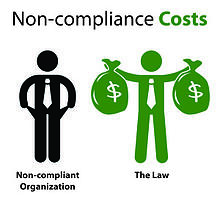 Overview
Overview
Compliance has been a buzz word for quite some time now - it’s a necessity and a way of life for most businesses, and I am here to show you just how important compliance actually is. Over the next few weeks, I will be covering everything you need to know about the ever-changing world of compliance. From Oracle Agile’s PLM environment for managing compliance to applications that help with the implementation process. And answering questions like, “where in the heck is conflict minerals going?”, “how do I architect my environment to meet compliance regulations?” and “how do I make the best decisions when picking vendors?” Each section will build upon the previous post, leaving you with the right tools to tackle any compliance issue your company is facing today and or in the future.
This post will be an introduction. It is the alarm that goes off at 6 am in the morning telling you it’s time to grab a coffee and wake up. It is the second alarm because you snoozed the first one. This introduction will show you the best steps for waking up your PLM system and digging deep into the real issues you are facing. Asking those initial questions to determine what your problem is and what are the possible solutions you can take. It can be overwhelming when starting any project, so let’s just take it one espresso at a time.
Questions and Concerns with Agile PG&C
To get things started, let’s address the most challenging question, “where do I start”? The issue always seems bigger when you can’t nail down what the problem is, what needs to change, and what it is you are looking for. As many of you know, there are many options available that can help with compliance. So to narrow down the topic, we are going to answer the question, Can Agile Product Governance and Compliance (PG&C) solve any of those problems for you?
- Can Agile PLM do compliance?
Yes. And it can do it very well. PG&C is an easy add-on module that pairs well with the Product Collaboration (PC) module. Right out of the box, PG&C is able to associate with Manufacturer Parts and Item assemblies, and it is flexible in how it interacts with these objects. Many companies have bought extra modules bundled with Agile PLM, so chances are, you already have PG&C and can take advantage of it immediately.
- What compliance does Agile PLM support?
You name it, and Agile PLM can do it. PG&C is most popular with the environmental directives of larger countries and industries. It is specifically able to track RoHS (requirements of hazardous substances) (EU, China, etc), REACH (Registration, Evaluation, Authorisation and Restriction of Chemicals) and Conflict Minerals, and it can also be configured for tracking FDA regulations.
Where it really shines though, is its ability to handle niche requirements such as: Casino regulations, firearms restrictions, and medical devices to name just a few. The capability comes by using Specifications, which can represent an environmental, industry, or internal company standard. If the regulation has measurable ranges of tolerances, those can be configured as well.
Once the specification is set up, it can applied to any level of the Bill of Materials, and the PG&C engine will track its progress upward and provide results at the most important level – the top level that is shipped to the client.
- How much data can PG&C support?
The compliance data in Agile PG&C is status-based, therefore it takes up very little space in relation to the rest of Agile PLM. In fact, there are very few database tables related to PG&C, as it is relational to PC assembly data.
If your company is high mix – low volume and you have hundreds and thousands of BoMs, you have to be wary of potential issues. First, the more assemblies you have, the larger the effort it takes to import the initial compliance data for your system – make sure you plan accordingly. It will take more compliance analysts to add compliance data initially and on-going basis. Second, your system can take longer to run compliance rollups to the top level assembly. This can easily be remedied by offloading this task to your company’s off-hours.
- Where do I get compliance data about my Bill of Materials?
The high-level objective of adding compliance information to your PLM is asking your manufacturers (or suppliers that represent manufacturers) for the material compositions of the parts you buy. It can be an unrealistic task if you are a company that buys from hundreds or thousands of these parties.
In recent years, there have been several data vendors that have offered service plans to take over the research and collation of this information. The data vendor will work directly with suppliers and manufacturers to receive composition data, then standardize it to give to customers. It’s a single source of information for your company and much easier than doing the work yourself. Some common examples of these companies, starting with the most popular include Total Parts Plus, SIliconExpert, Tachus, and TeleMatrix.
Once you start receiving the data from these vendors, the challenge lies with data being entered into your Agile PLM. There is no easy, straightforward process, and it requires the use of data import tools, such as LoadState Compliance Accelerator. This application does the heavy lifting for you, and is a must have for processing a lot of data with a few number of resources.
- This sounds complicated, will implementing PG&C take a long time? What if I don’t have the resources?
Each companies’ needs are different. You need to determine what your company’s compliance pain is to determine what needs to happen next. An industry expert, like ZWS, is a great resource to help analyze your company’s industry requirements and internal business rules. Compliance requires a multi-level approach. Implementing and setting up the module comes first and the customization comes second. Specific functionality should be broken down into individual phases for each compliance regulation you wish to implement. This approach is fundamental in order to avoid “perpetual development”. Like previous stated compliance is ever-changing so working towards a complete and perfect solution never comes to fruition.
Conclusion
Now that we’ve addressed the popular questions you may have concerning Agile PG&C, let’s begin! I can safely assume that there are many other questions regarding this topic, therefore, we will be providing additional information for those looking to find out more.
Don’t forget to check back for the next blog post on “Customizing Your Compliance: The importance of PX Automation”.
[Edit: Repost from 2015]


